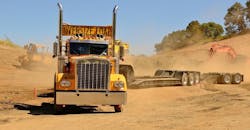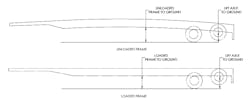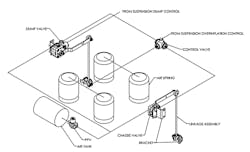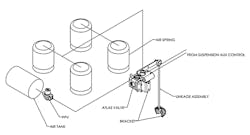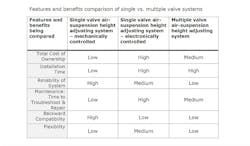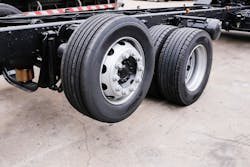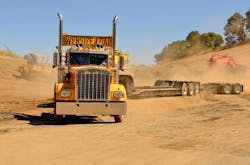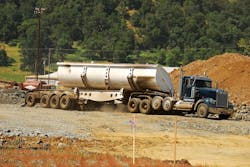Air-suspension height control valves for vocational vehicles
Executive summary
In operating vocational vehicles or trailers, one aspect of keeping costs down is dependent on preventing damage to either the chassis, the underside of the vehicle or trailer, and even the tires (such as in lowboy trailers). A common method has been to raise and lower the vehicle or trailer by a mechanism that the driver can control. Some of the more recent technologies utilize air-suspension to control ground clearance.
Typically, an air-suspension system with dual ride height relied on an air feed that was controlled by two or three valves. While such systems did work, they were unnecessarily complex as they utilized more than one height control valve, plus related accessories. This contributed to an increase in cost of ownership, and if such a system broke down, the downtime to troubleshoot and repair would correspondingly be unnecessarily long.
A better method has been developed—the single-valve system. Such a system is dependent on only one valve to achieve dual ride height. Only select valves can operate a single-valve dual ride height air-suspension system.
Overview
Vocational vehicles and trailers present unique design challenges for engineers due to the severe conditions such vehicles are exposed to throughout their use. This is particularly true for vocational vehicles in the heavy-duty transportation industry segment, as these vehicles and trailers often are used on uneven or unpaved terrain while heavily loaded. This class of vehicles has niche requirements and custom solutions to solve those needs are necessary.
Among the main demands placed on heavy-duty vocational vehicles is the need for additional ground clearance. Due to the diverse nature of uses to which vocational vehicles are exposed, ground clearance is one of the principal concerns for this class of vehicle. Chassis components frequently get damaged due to impact with obstacles or hillcrests on the road. Off-road vehicles face the same challenge.
Specific examples of uses that require additional ground clearance include the following:
Trucks and trailers that have either “pusher” or “tag” axles that can be lifted face the ongoing risk of raised tires hitting or rubbing against the ground. This can lead to expensive repairs.
Lowboy trailers that utilize lift axles face a unique challenge due to the nature of the chassis design as shown in the image below. Chassis are designed to deflect under the load. As the frame deflects, the frame-to-ground distance increases, which changes the ride height. Without a load on the trailer, the lifted tag axle has much less ground clearance, contributing to the risk of wear and tear of tag axle tires.
High centering can occur when a vehicle goes over an obstacle, such as a hillcrest, and becomes immobilized with either front or back axle suspended in air. This typically results in unnecessary delays in transport and almost invariably leads to damage of the chassis or the underside of the trailer.
Furthermore, when vocational trucks are driving off-road, additional ground clearance is required to drive over uneven road surfaces and obstacles. In these situations, it is an absolute requirement for the vehicle to have the option to raise the chassis to prevent damage to chassis components.
Conventional designs
To gain additional ground clearance, most truck and trailer OEMs currently utilize an additional ride height control valve. This second valve enables the truck or trailer to raise its chassis to a higher ride height. When higher ground clearance is required, the operator/system switches to the secondary height control valve. To make this system work, an additional control valve is needed to select between the two ride height control valves. While this system performs adequately, it is not considered cost-effective.
The list of factors adding to cost over what it would be in a single valve design includes:
- Three valves are used instead of one
- Additional brackets and linkages
- Additional fittings and tubing
- Increased labor cost due to setting the ride height via an additional valve, welding additional bracket to the frame, and installation of additional component
Factors that increase maintenance and operating cost for end user:
- Difficult to troubleshoot due to system complexity
- Additional potential leak paths
- In most cases, increased downtime when the system malfunctions
A revolutionary design:
A single-valve air-suspension (chassis) system
Single-valve dual ride height chassis systems are simpler, more cost-effective and more robust. A single-valve dual ride height air-suspension chassis system does the same work as a multiple-valve system and is used in the same applications. The difference is that multiple-valve systems require extra valves and corresponding hardware, adding to complexity and cost over the lifecycle of the system or vehicle. The same basic principles apply in the design and operation of a single-valve air- suspension chassis system.
However, a unique kind of valve is required to operate a single-valve system. The valve’s mechanism provides two different ride heights. The valve is coupled to an internal cartridge that selects between two ride heights when activated by a pilot signal initiated by the driver of the vehicle. In lift-axle applications, the installation is even simpler, as the same pilot signal can be used to select the second ride height as well. The second ride height can be customized based on intended use of the vehicle, and will be factory set to be anywhere between 1 to 4 inches. This is an efficient solution as it eliminates several components that a two-valve design requires. It is simpler to install, easier to troubleshoot and has a lower total cost of ownership. Typically, the valve deployed in the single valve configuration will include a quick dump feature and can be activated from either ride height.
The major benefits of using a single-valve design include easier and faster installation, easier and faster maintenance, and reduced downtime while in operation by end users—all leading to cost savings.
These savings accrue during the initial manufacturing process and continue throughout the service life of a vocational vehicle. Fewer valves and other parts are needed to produce a single-valve air-suspension setup, and fewer parts must be maintained or replaced by the end user over the life of the vehicle. A simpler system breaks down less frequently than a more complex one, and when it does, it is cheaper and easier to repair. Downtime is reduced, creating additional savings.
There are two single-valve technologies capable of operating a single-valve system: a mechanically operated one, and an electronically controlled one. Both technologies are available with additional features, such as second ride height, air retention and variable air flow. The mechanically controlled valve can act as a drop-in replacement to existing air-suspension setup without any modification to the air-suspension system or to the manufacturing process. Considering that a system utilizing a mechanically operated valve is simpler than an electronically controlled one, it will be more cost-effective and reliable over the lifecycle of the system or vehicle.
The cost benefit of using a single-valve air-suspension chassis design is significant, where manufacturers and end users will realize savings while not forfeiting any functionality. It is the future of air-suspension chassis design.
Features and benefits comparison of single- vs. multiple-valve systems
Typical applications
Pain point: Wear and damage to tires on the lift axle wheels.
When a trailer suspension lift axle is in raised position without a load on the trailer, the ground clearance below the raised wheels/tires can be too small. This usually causes hanging tires to impact ground at high speed, resulting in excessive damage and wear.
Single-valve solution
Raise the chassis using a single-valve air-suspension system. The valve can be plumbed into the lift axle circuit, making operation of the valve completely automated when the lift axle is raised. The lift axle is only raised when the trailer is empty to minimize effect on center of mass. Air circuit plumbing is simplified as only a single valve is used, enabling easy installation and maintenance. Total cost of ownership in comparison with multiple-valve systems is reduced.
Pain point: Damage to trailer resulting from forceful contact with ground or obstacles on the ground.
Lowboy trailers have a low ground clearance to meet the requirements of transporting heavy equipment. To overcome obstacles, the trailer suspension needs to be raised to a second ride height.
Single-valve solution
Using a single-valve air-suspension system provides two ride heights that can be switched by activating pilot pressure (operator control). The valve can exhaust to shift to the secondary ride height and lower a loaded trailer’s center of mass. When driving off-road or over obstacles, damage to the trailer is prevented or greatly reduced. Air circuit plumbing is simplified as only a single valve is used, enabling easy installation and maintenance. Total cost of ownership in comparison with multiple-valve systems is reduced.
Pain point: Wear and damage to truck chassis.
When vocational trucks operate off-road, additional clearance is needed to drive over uneven road surfaces and obstacles that can impact the truck chassis, causing damage.
Single-valve solution
Raise the chassis during off-road conditions to avoid contact with obstacles or the ground by deploying a single-valve air-suspension system in the vehicle chassis. Air circuit plumbing is simplified as only a single valve is used, enabling easy installation and maintenance. Total cost of ownership in comparison with multiple-valve systems is reduced.
Pain point: Damage to trailer or truck when its center hits the ground on hillcrests.
A trailer (or truck) can get stuck as its center contacts the ground or other obstacles, which can cause damage to the chassis or underside of the trailer, and likely result in undesirable delays in transport. Such “high-centering” can occur whenever a vehicle goes over an obstacle or hillcrest and becomes immobilized with either front or back axle suspended in air.
Single-valve solution
When approaching an obstacle such as a hillcrest, the driver can raise the trailer chassis to create greater ground clearance and avoid damage to the chassis or the underside of the trailer. This limits the potential for immobilization and damage to the truck or trailer resulting from “high centering” caused by obstacles including speed bumps and hillcrests.
Conclusion
Vocational vehicles have special requirements for their design. Due to where and how such vehicles are used, it is necessary to build these vehicles with enough ground clearance so that the underside does not contact the ground or obstacles while in transit over varied terrain, including off-road conditions. Certain engineering considerations, such as center of mass, which may destabilize a vehicle if it is too elevated, make it impractical to build certain classes of vocational vehicles with a fixed ground clearance sufficiently elevated to avoid hitting the ground or an obstacle in all situations.
The solution to this is to manufacture trucks and trailers with a suspension that can be raised or lowered while in operation, depending on the terrain. Early suspensions utilized leaf-spring or torsion-bar mechanisms. A more recent innovation is air-suspension that employs air springs, and such systems can vary the height of the chassis (and the vehicle) as needed. An air-suspension system requires valves or a single valve to control the amount of air pumped into or released from the air springs. The first such systems called for several valves controlling air pressure in the air springs. A more recent innovation utilizes a single valve in such air-suspension systems, resulting in reduced costs due to requiring fewer valves, hoses, couplings, etc. (the “plumbing”).
An additional benefit delivered by single-valve systems is greater simplicity, which reduces manufacturing and installation time, lowers maintenance costs and decreases downtime, as repairs are simpler and fewer parts are typically used. This all adds up to cost savings over the life of the vehicle and its suspension system when compared to a multiple-valve system.
Single-valve dual ride height air-suspension systems are available in two versions—electronically controlled and mechanically controlled. They perform the same functions. It could be argued that a mechanically controlled system will be more reliable over the long term, while being easier and more economical to install and maintain.
As is the case with technology in general, where a more cost-effective component or design performs as well as a more expensive one without any loss of function or performance, it ultimately replaces the more expensive one. This can be expected to take place in dual ride height air-suspension setups for vocational vehicles and trailers. OEMs can take on challenging applications with a simple and reliable solution using a single valve, while end users enjoy ongoing cost savings in operating their vehicles.
For more information, contact Victor Chau at [email protected].
About the Author
Jinesh Gandhi
Lead engineer
Gandhi holds a master's degree in Manufacturing Systems Engineering from California State University, Northridge, and a bachelor's in Mechanical Engineering from Nirma University, India.
